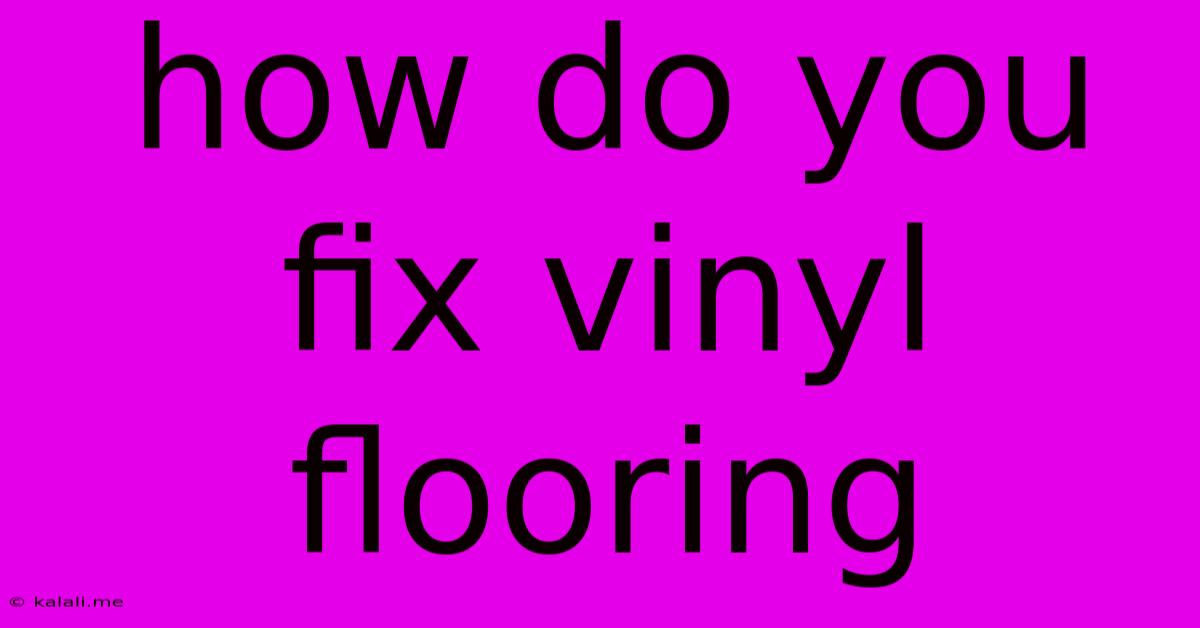How Do You Fix Vinyl Flooring
Kalali
May 20, 2025 · 3 min read

Table of Contents
How to Fix Vinyl Flooring: A Comprehensive Guide
Meta Description: Learn how to repair common vinyl flooring problems like scratches, dents, and gaps with our comprehensive guide. We cover DIY fixes for bubbling, peeling, and seam issues, saving you time and money.
Vinyl flooring is a popular choice for its durability, affordability, and ease of maintenance. However, even the toughest vinyl can suffer damage over time. From minor scratches to significant bubbling, knowing how to fix these issues yourself can save you money and the hassle of calling in a professional. This guide provides step-by-step instructions for tackling common vinyl flooring problems.
Common Vinyl Flooring Problems and Their Fixes
Before diving into repairs, let's identify the common issues you might encounter:
- Scratches: Superficial scratches are often easily concealed.
- Dents: Dents can be more challenging but are often fixable.
- Bubbling: This usually indicates a problem with the adhesive underneath.
- Peeling: Similar to bubbling, but more severe, requiring a more involved fix.
- Seams Coming Apart: This is a common issue, especially in high-traffic areas.
- Tears: Large tears may require patching or replacement.
Repairing Minor Damage: Scratches and Dents
For minor scratches, a vinyl floor repair kit often works wonders. These kits usually contain colored fillers that match your flooring. Simply apply the filler, let it dry, and then lightly buff the area to blend it seamlessly. For deeper scratches, consider using a touch-up pen designed for vinyl floors. Experiment in an inconspicuous area first to ensure a color match.
Dents, on the other hand, require a slightly different approach. If the dent is shallow, you might be able to carefully lift it using a heat gun (use low heat and avoid direct contact). Apply gentle, even pressure while heating the area. For deeper dents, you might need to carefully cut out the damaged section and replace it with a matching piece of vinyl. This requires precise cutting and careful matching, so it’s a more advanced technique.
Addressing More Serious Issues: Bubbling, Peeling, and Seams
Bubbling vinyl flooring usually points to a problem with the adhesive beneath. For small bubbles, carefully pierce the bubble with a pin, then press the air out from the center, working your way outwards. Use a heavy object, such as a book, to weigh down the area for 24-48 hours, allowing the adhesive to re-bond. If the bubbling is extensive, you might need to carefully lift the affected section and reapply adhesive. This often requires removing the existing adhesive first.
Peeling is a more serious issue and often requires a more extensive repair. Similar to bubbling, you'll likely need to lift the affected section, clean the subfloor, and reapply adhesive. For large areas, you may need to replace the entire section of flooring.
If your vinyl seams are coming apart, you can use a vinyl seam sealer to reinforce the bond. Clean the seam thoroughly and apply the sealer according to the manufacturer's instructions. Allow ample drying time before walking on the area.
Repairing Tears in Vinyl Flooring
Tears require a more involved repair process. Smaller tears can sometimes be repaired using a vinyl patch kit. Carefully clean the area and apply the patch, following the kit's instructions. For larger tears, replacement is usually the best option, unless you're adept at working with vinyl and have access to a matching piece.
When to Call a Professional
While many vinyl flooring repairs are DIY-friendly, some situations require professional expertise:
- Extensive damage: Large areas of bubbling, peeling, or tearing may necessitate professional help.
- Complex repairs: If you're unsure about any step or lack the necessary tools, a professional can ensure a clean, lasting fix.
- Water damage: Water damage often leads to mold growth, posing health risks and making DIY repairs unsafe.
By understanding the common problems and following these tips, you can successfully tackle many vinyl flooring repairs yourself, extending the life and beauty of your floor. Remember to always prioritize safety and choose the appropriate repair method for the severity of the damage.
Latest Posts
Latest Posts
-
What Is The Dot On The I Called
May 20, 2025
-
Word For The Day Before Yesterday
May 20, 2025
-
Can You Carry On Candles On A Plane
May 20, 2025
-
What Happens If You Eat Bad Feta Cheese
May 20, 2025
-
When Connecting A Battery Which Terminal First
May 20, 2025
Related Post
Thank you for visiting our website which covers about How Do You Fix Vinyl Flooring . We hope the information provided has been useful to you. Feel free to contact us if you have any questions or need further assistance. See you next time and don't miss to bookmark.